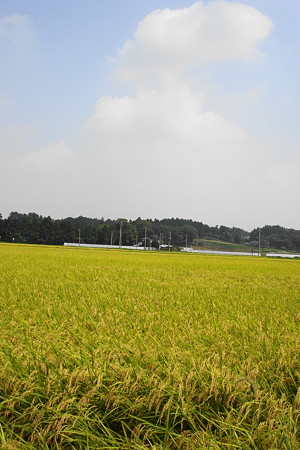
Because of the cold weather, the lava plateau and the soil with little mineral and nutrition, Fujiyoshida City was once thought to be not suitable for rice cultivation. Because I had such a prejudice since little, I was so surprised that Kaneyama-En, one of the famous hot spring inns in Fujiyoshida, was surrounded by rice fields!
Mukawa-mai Rice is the most famous rice brand in Yamanashi Prefecture, but recently, "Milky Way" is getting popular as it won the gold prize in Japan Rice Fair in 2002.
Thanks to the great effort of rice farmers in Fujiyoshida, rice can be cropped in the northern foot area of Mt. Fuji.
Rice has long been the staple food of Japan, and it still makes frequent appearances on the dining table.
Japan maintains near-100-percent self-sufficiency in rice, and this is an amazing number considering low overall food self-sufficiency. There are many ways to eat rice but the standard way is to eat it plain. The flavour of rice is relatively simple, so all sorts of side dishes go well with it.
Japan is the northernmost country where rice is cultivated.
Rice is the staple food in many countries, such as China, Korea, India, Thailand and other countries in Southeast Asia.

Looking at Thai style of rice cropping, I always feel, "Was rice easy growing !?", and I also thank Japanese farmer's great effort in the hash weather.
In Thailand, farmers sow rice seeds in the field straight away unlike in Japan - we sow seeds in the planters and let it grow to be small rice plants first, and then we replant these into the paddling rice fields.
As far as I know, all my Thai friends sow rice seeds in the field.
On the top of it, it is not necessary to spray insecticides on rice field, too if it is for family.
Two or Three corps a years is usual.
I have hardly seen the rice field near my house without rice plants!
Rice cultivation in Thailand looks much more easygoing than in Japan, and it is nothing else but the climate in Japan makes things very difficult.
Japanese thought hard, and underwent the improvement and development of variety of rice plants.
This is the field that Japanese are good at, to exercise ingenuity to make like better in a country with many natural disasters and hash weather.

"Milky Way", one of the rice brands, is suitable for growing in high and cold area, but the soil in Fujiyoshida City is lack of mineral and nutrition due to volcanic ash and lava by eruptions of Mt. Fuji.
Organic farming and soil conditioning made it possible to harvest such tasty rice in Fujiyoshida.
On the other hand, rice needs the snow-melt water streaming down from Mt. Fuji to grow up.
Lliving with good and bad - I feel that rice cultivation in the city really metaphors the relationship between Mt. Fuji and Fujiyoshida.
Transportation has so much developed in the city, but in old days, it was a serious problem whether rice and vegetables can be grown up or now.

Since "Big Eruption in Houei Era" in 1707, Mt. Fuji has not erupted for many years, but people who live on the foot of the mountain always feared the future eruption, and that fear leads people to Fire Festival of Fujiyoshida, which is counted as one of the Three Peculiar Festivals in Japan.
Fire Festival of Fujiyoshida is on 26th and 27th August every year.
A portable shrine called Oyama-san is dropped on the ground three times wishing a peaceful coming year without eruption of Mt. Fuji.
After a portable shrine is carried around the town, near at dusk, big touches made of straws are lit along the main street, and the whole town is filled with fantastic atmosphere.
This Fire Festival is derived from the Shinto myth that Kono-hana-sakuya-hime (Blossom Princess) gave birth to three sons in raging flame proving her innocence to her husband. Controlling fire with fire.
This Festival is also the one thanking Mt. Fuji for good mountain climbing season, and people in Fujiyoshida feels the end of summer season.

Fujiyoshida City where Mr. Masahiko Shimura, who is the main songwriter of Fujifabric, was born and brought up.
His wonderful music could be born becuase he was given birth in this town, in this natural environment, and in this culture.
It is my pleasure if yesterday's and today's posts can help you to understand "why the name of the Fujifabric's newsletter is Akafuji Tsushin" and "why Mt. Fuji is on the CD jacket of Sugar!!" and "why Mr. Shimura's photo was on the top of Mt. Fuji in his funeral service, Shimura-kai.
Scientists reported that permafrost on the southern area of Mt. Fuji melted down, and the life cycle and ecosystem will be gradually changed in the future. How did the goddess of Mt. Fuji, Blossom Princess, feel to hear that news?
Today's song is "Ukigumo".

No comments:
Post a Comment